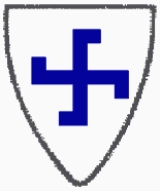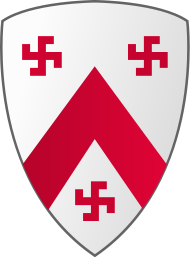
Fylfot
Encyclopedia
Fylfot or fylfot cross (icon (fil-fot), is a synonym
for swastika
, sometimes used in Britain
.
However – at least in modern heraldry texts, such as Friar and Woodcock & Robinson (see below) – the fylfot differs somewhat from the archetypal form of the swastika: always upright and typically with truncated limbs, as shown in the figure at right.
for this is that it comes from the notion common among nineteenth-century antiquarian
s, but based on only a single 1500 manuscript, that it was used to fill empty space at the foot of stained-glass
window
s in medieval churches. This etymology is often cited in modern dictionaries (such as the Collins English Dictionary and Merriam-Webster OnLine).
Thomas Wilson (1896), suggested other etymologies, now considered untenable:
 In modern heraldry texts the fylfot is typically shown with truncated limbs, rather like a cross potent that's had one arm of each T cut off. It's also known as a cross cramponned, ~nnée, or ~nny, as each arm resembles a crampon or angle-iron (compare Winkelmaßkreuz in German
In modern heraldry texts the fylfot is typically shown with truncated limbs, rather like a cross potent that's had one arm of each T cut off. It's also known as a cross cramponned, ~nnée, or ~nny, as each arm resembles a crampon or angle-iron (compare Winkelmaßkreuz in German
).
Examples of fylfots in heraldry are extremely rare, and the charge is not mentioned in Oswald Barron's article on "Heraldry" in most 20th-century editions of Encyclopædia Britannica. A twentieth century example (with four heraldic roses) can be seen in the Lotta Svärd
emblem.
Parker's Glossary of Heraldry (see below) gives the following example:
(In lieu of an image from this MS., a modern rendering of this blazon is shown on the right.)
Even in the last few centuries the fylfot is conspicuous by its absence from grants of arms (understandably so since 1945; see: Swastika – Stigma).
However, it was only rarely used. Wilson, writing in 1896, says, "The use of Fylfot is confined to comparatively few persons in Great Britain and, possibly, Scandinavia. Outside of these countries it is scarcely known, used, or understood."
In more recent times, fylfot has gained greater currency within the areas of design history and collecting, where it is used to distinguish the swastika motif as used in designs and jewellery from that used in Nazi paraphernalia. Even though the swastika does not derive from Nazism, it has become associated with it, and fylfot functions as a more acceptable term for a "good" swastika.
House of Commons Hansard Debates for 12 Jun 1996 (pt 41) reports a discussion about the badge of No. 273 Fighter Squadron, Royal Air Force
. In this, fylfot is used to describe the ancient symbol, and swastika used as if it refers only to the symbol used by the Nazis.
Odinic Rite
(OR), a Germanic pagan
organization, use both "swastika" and "fylfot" for what they claim as a "holy symbol of Odinism". The OR fylfot is depicted with curved outer limbs, more like a "sunwheel swastika" than a traditional (square) swastika or heraldic fylfot. http://web.archive.org/web/20091027105613/http://geocities.com/odinistlibrary/OLArticles/TruthSwastikaFylfot.htm
Synonym
Synonyms are different words with almost identical or similar meanings. Words that are synonyms are said to be synonymous, and the state of being a synonym is called synonymy. The word comes from Ancient Greek syn and onoma . The words car and automobile are synonyms...
for swastika
Swastika
The swastika is an equilateral cross with its arms bent at right angles, in either right-facing form in counter clock motion or its mirrored left-facing form in clock motion. Earliest archaeological evidence of swastika-shaped ornaments dates back to the Indus Valley Civilization of Ancient...
, sometimes used in Britain
United Kingdom
The United Kingdom of Great Britain and Northern IrelandIn the United Kingdom and Dependencies, other languages have been officially recognised as legitimate autochthonous languages under the European Charter for Regional or Minority Languages...
.
However – at least in modern heraldry texts, such as Friar and Woodcock & Robinson (see below) – the fylfot differs somewhat from the archetypal form of the swastika: always upright and typically with truncated limbs, as shown in the figure at right.
Etymology
The most commonly cited etymologyEtymology
Etymology is the study of the history of words, their origins, and how their form and meaning have changed over time.For languages with a long written history, etymologists make use of texts in these languages and texts about the languages to gather knowledge about how words were used during...
for this is that it comes from the notion common among nineteenth-century antiquarian
Antiquarian
An antiquarian or antiquary is an aficionado or student of antiquities or things of the past. More specifically, the term is used for those who study history with particular attention to ancient objects of art or science, archaeological and historic sites, or historic archives and manuscripts...
s, but based on only a single 1500 manuscript, that it was used to fill empty space at the foot of stained-glass
Stained glass
The term stained glass can refer to coloured glass as a material or to works produced from it. Throughout its thousand-year history, the term has been applied almost exclusively to the windows of churches and other significant buildings...
window
Window
A window is a transparent or translucent opening in a wall or door that allows the passage of light and, if not closed or sealed, air and sound. Windows are usually glazed or covered in some other transparent or translucent material like float glass. Windows are held in place by frames, which...
s in medieval churches. This etymology is often cited in modern dictionaries (such as the Collins English Dictionary and Merriam-Webster OnLine).
Thomas Wilson (1896), suggested other etymologies, now considered untenable:
- "In Great Britain the common name given to the Swastika from Anglo-Saxon times ... was Fylfot, said to have been derived from the Anglo-SaxonOld English languageOld English or Anglo-Saxon is an early form of the English language that was spoken and written by the Anglo-Saxons and their descendants in parts of what are now England and southeastern Scotland between at least the mid-5th century and the mid-12th century...
fower fot, meaning four-footed, or many-footed." - "The word [Fylfot] is Scandinavian and is compounded of Old NorseOld NorseOld Norse is a North Germanic language that was spoken by inhabitants of Scandinavia and inhabitants of their overseas settlements during the Viking Age, until about 1300....
fiǫl-, equivalent to the Anglo-Saxon fela, German viel, "many", and fótr, "foot", the many-footed figure." The Germanic root fele is cognate with English full, which has the sense of "many". Both fele and full are in turn related to the Greek poly-, all of which stem from the proto-Indo-EuropeanProto-Indo-European languageThe Proto-Indo-European language is the reconstructed common ancestor of the Indo-European languages, spoken by the Proto-Indo-Europeans...
root *ple-. A fylfot is thus a "poly-foot", to wit, a "many-footed" sigil.
In heraldry

German language
German is a West Germanic language, related to and classified alongside English and Dutch. With an estimated 90 – 98 million native speakers, German is one of the world's major languages and is the most widely-spoken first language in the European Union....
).
Examples of fylfots in heraldry are extremely rare, and the charge is not mentioned in Oswald Barron's article on "Heraldry" in most 20th-century editions of Encyclopædia Britannica. A twentieth century example (with four heraldic roses) can be seen in the Lotta Svärd
Lotta Svärd
Lotta Svärd was a Finnish voluntary auxiliary paramilitary organisation for women. During the Finnish Civil War it was associated with the Suojeluskunta. After the war Lotta Svärd was founded as a separate organisation on September 9, 1920. The name comes from a poem by Johan Ludvig Runeberg...
emblem.
Parker's Glossary of Heraldry (see below) gives the following example:
- Argent, a chevron between three fylfots gules--Leonard CHAMBERLAYNE, Yorkshire [so drawn in MS. Harleian, 1394, pt. 129, fol. 9=fol. 349 of MS.]
(In lieu of an image from this MS., a modern rendering of this blazon is shown on the right.)
Even in the last few centuries the fylfot is conspicuous by its absence from grants of arms (understandably so since 1945; see: Swastika – Stigma).
Modern use of the term
From its use in heraldry - or from its use by antiquaries - fylfot has become an established word for this symbol, in at least British English.However, it was only rarely used. Wilson, writing in 1896, says, "The use of Fylfot is confined to comparatively few persons in Great Britain and, possibly, Scandinavia. Outside of these countries it is scarcely known, used, or understood."
In more recent times, fylfot has gained greater currency within the areas of design history and collecting, where it is used to distinguish the swastika motif as used in designs and jewellery from that used in Nazi paraphernalia. Even though the swastika does not derive from Nazism, it has become associated with it, and fylfot functions as a more acceptable term for a "good" swastika.
House of Commons Hansard Debates for 12 Jun 1996 (pt 41) reports a discussion about the badge of No. 273 Fighter Squadron, Royal Air Force
Royal Air Force
The Royal Air Force is the aerial warfare service branch of the British Armed Forces. Formed on 1 April 1918, it is the oldest independent air force in the world...
. In this, fylfot is used to describe the ancient symbol, and swastika used as if it refers only to the symbol used by the Nazis.
Odinic Rite
Odinic Rite
The Odinic Rite is a religious organization, practicing a form of Northern Indo European religion termed Odinism after the chief god of Norse mythology, Odin...
(OR), a Germanic pagan
Germanic paganism
Germanic paganism refers to the theology and religious practices of the Germanic peoples of north-western Europe from the Iron Age until their Christianization during the Medieval period...
organization, use both "swastika" and "fylfot" for what they claim as a "holy symbol of Odinism". The OR fylfot is depicted with curved outer limbs, more like a "sunwheel swastika" than a traditional (square) swastika or heraldic fylfot. http://web.archive.org/web/20091027105613/http://geocities.com/odinistlibrary/OLArticles/TruthSwastikaFylfot.htm
See also
- KolovratKolovratKolovrat or kolowrat means spinning wheel in a number of Slavic languages : "kolo" means "wheel", "vrat" is the stem for "turning/spinning/etc." It may also be an archaic form of the East Slavic word kolovorot for "brace". Kolo symbolizes the Sun...
- JainismJainismJainism is an Indian religion that prescribes a path of non-violence towards all living beings. Its philosophy and practice emphasize the necessity of self-effort to move the soul towards divine consciousness and liberation. Any soul that has conquered its own inner enemies and achieved the state...
- SwastikaSwastikaThe swastika is an equilateral cross with its arms bent at right angles, in either right-facing form in counter clock motion or its mirrored left-facing form in clock motion. Earliest archaeological evidence of swastika-shaped ornaments dates back to the Indus Valley Civilization of Ancient...
- TriskelionTriskelionA triskelion or triskele is a motif consisting of three interlocked spirals, or three bent human legs, or any similar symbol with three protrusions and a threefold rotational symmetry. Both words are from Greek or , "three-legged", from prefix "τρι-" , "three times" + "σκέλος" , "leg"...
- Western use of the Swastika in the early 20th centuryWestern use of the Swastika in the early 20th centuryThe swastika is an equilateral cross with its arms bent at right angles, in either right-facing form or its mirrored left-facing form. Archaeological evidence of swastika-shaped ornaments dates from the Neolithic period and was first found in the Indus Valley Civilization of the Indian...
External links
- Online versions of Wilson's book, The Swastika:
- The Swastika
- Swaztika (sic) (a scan of the original publication)
- Symbol 15:1 – Symbols.com

